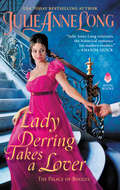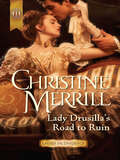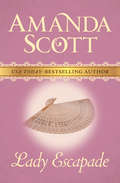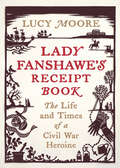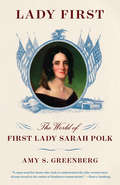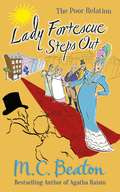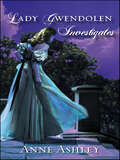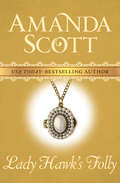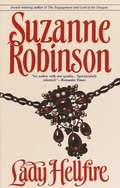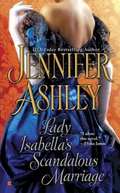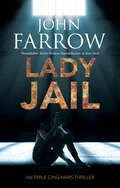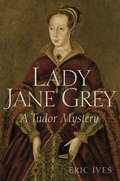- Table View
- List View
Lady Derring Takes a Lover: The Palace of Rogues (The Palace of Rogues)
by Julie Anne LongA mistress. A mountain of debt. A mysterious wreck of a building.Delilah Swanpoole, Countess of Derring, learns the hard way that her husband, “Dear Dull Derring,” is a lot more interesting—and perfidious—dead than alive. It’s a devil of an inheritance, but in the grand ruins of the one building Derring left her, are the seeds of her liberation. And she vows never again to place herself at the mercy of a man.But battle-hardened Captain Tristan Hardy is nothing if not merciless. When the charismatic naval hero tracks a notorious smuggler to a London boarding house known as the Rogue’s Palace, seducing the beautiful, blue-blooded proprietress to get his man seems like a small sacrifice.They both believe love is a myth. But a desire beyond reason threatens to destroy the armor around their hearts. Now a shattering decision looms: Will Tristan betray his own code of honor…or choose a love that might be the truest thing he’s ever known?
Lady Disaster
by Amanda MarielIl Marchese di Gulliver, Seth Mowbray, non ha una famiglia tutta sua. Quando non è in compagnia dei suoi cari amici, il Duca e la Duchessa di Selkirk, annega la sua solitudine indulgendo alle cose più malvagie che la vita ha da offrire. Lady Constantine Hartley non sembra voler seguire le regole della società. La pressione e le aspettative le hanno guastato tutto il divertimento, perché allora preoccuparsi? Durante quest’ultima Stagione ha deciso di ignorare le regole e divertirsi. Dopo un incontro casuale, Seth si ritrova affascinato dall’infernale Lady Constantine. Allo stesso modo, Constantine si ritrova affascinata dal Marchese. Due paria della società possono sfidare la sorte e conquistare il vero amore?
Lady Drusilla's Road to Ruin (Ladies in Disgrace #1085)
by Christine MerrillConsidered a spinster, Lady Drusilla Rudney has only one role in life: to chaperone her sister. So when her flighty sibling elopes, Dru knows she has to stop her! She employs the help of a traveling companion, who looks harmless enough....Former army captain John Hendricks is intrigued by this damsel in distress. Once embroiled with her in a mad dash across England, he discovers that Dru is no simpering woman. Her unconventional ways make him want to forget his gentlemanly conduct...and create a scandal all their own!
Lady Eleanor's Seventh Suitor (The Sutherlands #1)
by Anna BradleyTo protect her sister, a lady determined to marry for love must accept a devious suitor&’s dubious proposal in this Regency romance series debut. There have been six suitors so far, all vying for the attention—and generous dowry—of the beautiful, elusive Eleanor Sutherland. But what will it take to melt the heart of the so-called Lady Frost? Camden West is determined to find out for himself . . . and he has a secret weapon. Cam knows that Ellie&’s sister, Charlotte, harbors a scandalous secret—one that could bring ruin to the Sutherland name. If Ellie marries him, Cam promises to keep mum. But is she willing to sacrifice her own happiness for her sister&’s reputation? To Ellie&’s surprise, it becomes clear that Cam doesn&’t need her money, nor is he interested in her status. Soon, what begins as a sham engagement transforms into something deeper, and more passionate, than Ellie could have imagined. Is it possible that all Cam truly wanted was her? Or could he be hiding something else? Even for a lady in love, only the truth will do.
Lady Elinor's Wicked Adventures
by Lillian MarekLady Elinor is searching for treasure The intrepid Lady Elinor Tremaine is caught up in the Victorian fervor for exploring distant lands. Her travels throw her back in the company of an old friend-this time, far from the security of polite society. And uncovering the secrets of her own heartHarry de Vaux, Viscount Tunbury, has loved Lady Elinor for as long as he can remember- but his family's sordid background put her completely out of his reach. Prowling through Etruscan ruins in Italy with Elinor is exquisite torture. She is so close, and so forbidden. . .
Lady Emma's Dilemma
by Rhonda WoodwardRhonda Woodward brings "writing that shines" (All About Romance) to a Signet Regency Romance classic... AVAILABLE DIGITALLY FOR THE FIRST TIME A lady forgives...but can she forget? What a dreadful misfortune that Lady Emmaline Fallbrook's grand return to London is spoiled by a sighting of Jack Devreux. He was the cad who endangered her reputation one impetuous night thirteen years ago and abandoned her. She is over him certainly, so hang the man--and the memories! But for someone who doesn't deserve a second thought, why is he consuming Emma's every thought? Baron Devreux is outraged. The unforgettable beauty who humiliated him on the most important night of his life is back, but why? The answers come under moonlight, with the promise of a little mischief and the unraveling of a soul-wrenching misunderstanding that could save two hearts from making the same mistake again... Don't miss other Signet Regency Romances by Rhonda Woodward: Moonlight and Mischief, A Hint of Scandal, A Spinster's Luck, and The Wagered Heart.
Lady Escapade
by Amanda ScottNow that they've married, is the beautiful new Countess of Andover's husband too masterful?Diana Sterling, having fallen deeply in love with Simon Warrington, Earl of Andover, and now his countess, is no longer inclined to fulfill his every whim. Since Simon seems bent on changing her, she has rebelled. Known as "Lady Escapade," she vigorously resists Simon's attempts to curb her defiant behavior and heedless flirtations, widening the gap between them. So when she embarks on her most dangerous escapade yet, will Simon be able to save her . . . and their marriage?
Lady Eve's Indiscretion (Windham Series #7)
by Grace BurrowesUSA Today Bestseller!"Burrowes delivers red-hot chemistry with a masterful mix of playfulness and sensuality."—Publishers Weekly Starred ReviewLady Eve's Got The Perfect PlanPretty, petite Evie Windham has been more indiscreet than her parents, the Duke and Duchess of Moreland, suspect. Fearing that a wedding night would reveal her past, she's running out of excuses to dodge adoring swains. Lucas Denning, the newly titled Marquis of Deene, has reason of his own for avoiding marriage. So Evie and Deene strike a deal, each agreeing to be the other's decoy. At this rate, matrimony could be avoided indefinitely...until the two are caught in a steamy kiss that no one was supposed to see.Windham series:The Heir (Book 1)The Soldier (Book 2)The Virtuoso (Book 3)Lady Sophie's Christmas Wish (Book 4)Lady Maggie's Secret Scandal (Book 5)Lady Louisa's Christmas Knight (Book 6)Lady Eve's Indiscretion (Book 7)Lady Jenny's Christmas Portrait (Book 8)Praise for Lady Maggie's Secret Scandal:"A tantalizing, delectably sexy story that is one of the best yet from an author on the way to the top."—Library Journal Starred Review"A delight...strikingly unique characters with realistic emotions and exciting antics."—RT Book Reviews, 4 Stars"Captivating...historical romance at its finest and rife with mystery and intrigue."—Romance Fiction on Suite 101
Lady Fanshawe's Receipt Book: The Life and Times of a Civil War Heroine
by Lucy MooreIn the mid seventeenth century, England was divided by war and bloodshed. Torn apart by rival factions, father opposed son and brother met brother on the battlefield. But while civil war raged on cobbled streets and green fields, inside the home domestic life continued as it always had done. For Ann Fanshawe and her children it meant a life of insecurity and constant jeopardy as she and her husband, a Royalist diplomat, dedicated their lives to the restoration of the Stuart monarchy. In this uncertain world, Ann's 'receipt book' was a treasured and entirely feminine response to the upheavals of war. These books were a feature of women's lives during this period, when there were few doctors to be found, and were full of life-saving medical knowledge that had been gleaned from mothers and friends. Remarkably, Ann's morocco-bound book full of scraps of ink-stained paper has survived to this day.Using Ann's receipt book and the memoirs she wrote for her surviving son, Lucy Moore follows her through this turbulent time as she leaves home, marries, bears - and buries - children and seeks to hold her family together. Lady Fanshawe's Receipt Book brilliantly brings to life Ann's struggles and her joys, revealing how ordinary women across the country fought to protect their loved ones in the face of conflict.
Lady First: The World of First Lady Sarah Polk
by Amy S. GreenbergThe little-known story of remarkable First Lady Sarah Polk--a brilliant master of the art of high politics and a crucial but unrecognized figure in the history of American feminism.While the Woman's Rights convention was taking place at Seneca Falls in 1848, First Lady Sarah Childress Polk was wielding influence unprecedented for a woman in Washington, D.C. Yet, while history remembers the women of the convention, it has all but forgotten Sarah Polk. Now, in her riveting biography, Amy S. Greenberg brings Sarah's story into vivid focus. We see Sarah as the daughter of a frontiersman who raised her to discuss politics and business with men; we see the savvy and charm she brandished in order to help her brilliant but unlikeable husband, James K. Polk, ascend to the White House. We watch as she exercises truly extraordinary power as First Lady: quietly manipulating elected officials, shaping foreign policy, and directing a campaign in support of America's expansionist war against Mexico. And we meet many of the enslaved men and women whose difficult labor made Sarah's political success possible.Lady First also shines a light on Sarah's many layers and contradictions. While her marriage to James was one of equals, she firmly opposed the feminist movement's demands for what she perceived to be far-reaching equality. She banned dancing and hard liquor from the White House, but did more entertaining than any of her predecessors. During the Civil War, she operated on behalf of the Confederacy even though she claimed to be neutral. And in the late nineteenth-century, she became a celebrity among female Christian temperance reformers, while she struggled to redeem her husband's tarnished political legacy.Sarah Polk's life spanned nearly the entirety of the 19th-century. But her own legacy, which profoundly transformed the South, continues to endure. Comprehensive, nuanced, and brimming with invaluable insight, Lady First is a revelation of our eleventh First Lady's complex but essential part in American feminism.
Lady Folbroke's Delicious Deception (Ladies in Disgrace #1081)
by Christine MerrillEmily Longesley married the love of her life and hoped that he would learn to love her. Instead, he upped and left their country estate for London. Suffering the snub with dignity, three years on Emily has had enough!Confronting her errant husband, Emily sees that Adrian, Earl of Folbroke, has been robbed of his sight and doesn't know her at all! Emily longs for her husband's touch. If she plays his mistress by delicious deception, can he finally learn to love his wife?
Lady Fortescue Steps Out (The Poor Relation)
by M.C. BeatonThe first book in M.C. Beaton's charming Poor Relation series. What do you do if you are of noble stock, but impoverished, and living in London with a certain style to maintain? One has to work... but One's relatives will be appalled when One turns One's hand to trade - and opens a hotel, The Poor Relation, offering employment to others of the same social standing and in the same awkward situation. This is precisely what Mrs Fortescue decides upon and, together with friend Colonel Sandhurst, transforms her decrepit Bond Street home into a posh hotel, offering guests the pleasure of being waited upon by the nobility. So with the help of other down-and-out aristocrats they do just that - and London's newest, and most fashionable! - hotel is born... much to the dismay of the Duke of Rowcester, Lady Fortescue's nephew, who is convinced his aunt's foray into trade will denigrate the illustrious family name!'Romance fans are in for a treat' - Booklist'[M. C. Beaton] is the best of the Regency writers' - Kirkus Reviews
Lady Fortescue Steps Out (The Poor Relation)
by M.C. BeatonThe first book in M.C. Beaton's charming Poor Relation series. What do you do if you are of noble stock, but impoverished, and living in London with a certain style to maintain? One has to work... but One's relatives will be appalled when One turns One's hand to trade - and opens a hotel, The Poor Relation, offering employment to others of the same social standing and in the same awkward situation. This is precisely what Mrs Fortescue decides upon and, together with friend Colonel Sandhurst, transforms her decrepit Bond Street home into a posh hotel, offering guests the pleasure of being waited upon by the nobility. So with the help of other down-and-out aristocrats they do just that - and London's newest, and most fashionable! - hotel is born... much to the dismay of the Duke of Rowcester, Lady Fortescue's nephew, who is convinced his aunt's foray into trade will denigrate the illustrious family name!'Romance fans are in for a treat' - Booklist'[M. C. Beaton] is the best of the Regency writers' - Kirkus Reviews
Lady Fortescue Steps Out: A Novel Of Regency England - Being The First Volume Of The Poor Relation (The Poor Relation Series #1)
by M. C. BeatonAn impoverished widow opens a hotel serving the society she has fallen from in this regency romance featuring characters who &“leap off the pages&” (Publishers Weekly). After her husband&’s death, Lady Fortescue knows she must work, even though the thought will appal her society relatives. So she decides to transform her once-grand Bond Street home into a hotel, the Poor Relation, offering society guests the pleasure of being waited upon by nobility. With the help of other down-and-out aristocrats, London&’s newest, most fashionable hotel is born. And it is the perfect venue for Lady Fortescue to play with the love lives of her guests and staff, starting with her nephew, the dashing Duke of Rowcester. Lady Fortescue has it on good authority that the duke once shared a dance with darling Harriet James, the hotel cook. When the duke comes to London, Lady Fortescue orchestrates a reunion that is sure to scandalize the ton . . . New York Times bestseller M.C. Beaton, the pen name for regency author Marian Chesney, &“expertly sets the scene, recapturing the bawdiness and color of a long-ago time. . . . Hilarious and tragic; larceny, attempted murder, a satisfactory love affair and unlikely alliances make the hotel the liveliest spot in London&” (Publishers Weekly). &“A charming and humorous Regency.&” —Library Journal &“A solid cast of eccentrics.&” —Booklist
Lady Gone Bad (Gone Bad #1)
by Sabine StarrA Woman's SecretsThe saloon singer known as Lady Gone Bad is the most drop-dead gorgeous outlaw the West has ever seen. Lady has never met a cowboy she couldn't entice, or a lawman she couldn't outrun. But when Lady tangles with a sexy U.S. Marshall, she's tempted to stick around long enough to watch him lay down the law--in her bed. A Man's DesiresU. S. Marshall Rafe Morgan wants to lock up Lady Gone Bad for good--and he won't let his attraction to her slow him down. But when his attempt to bring Lady to justice goes awry, Rafe is nearly hanged--and by dawn, his face is plastered next to hers on every "Wanted" poster in Texas. A Passion UnleashedNow on the run together, Rafe and Lady find themselves in very close quarters--and even more compromising positions. As Lady surrenders to Rafe's touch, she slowly begins to reveal all her secrets--including her real name. Maybe Lady Gone Bad isn't beyond redemption after all. Either way, Rafe is in for one wild ride. . ."An exciting read!" --New York Times bestselling author Bobbi Smith
Lady Gwendolen Investigates
by Anne AshleyElegant yet feisty, well traveled yet innocent to the world, beautiful yet modest-prying into others' lives isn't for Lady Gwendolen Warrender. Until murder and mayhem come to Marsden Wood!And every good sleuth needs a partner. Who better than dashing master of the manor Jocelyn Northbridge? With his touch of arrogance, intelligent eyes and brooding chivalry, she knows he'll make the perfect accomplice. But soon the renowned bachelor has more than solving murder in mind.It seems Gwendolen may have uncovered her very own marriage proposal!
Lady Hawk's Folly
by Amanda ScottWhen her husband returns from war, the Marchioness of Hawkstone battles for her independenceLess than two weeks after their wedding, Gavin Colporter, Marquess of Hawkstone, left his lovely wife Mollie at home and went off to war with Lord Wellington. Four years later, Mollie has become accustomed to running the estate and doing as she pleases. It&’s quite a shock when Hawkstone returns and immediately begins to assume his rights and responsibilities as lord of the manor. Can she learn to submit to his authority? What will he say when he hears certain scandalous rumors about her activities in his absence? And can these two near-strangers actually learn to live together as husband and wife?
Lady Helena's Secret Husband
by Elizabeth BeaconAn intense second chance storyHer secret husband…Is back from the dead! When Lady Helena Snowe eloped with Captain William Harborough six years ago, they had one glorious week together before he went to war—only to die in battle. Yet, the man in front of her now is very much alive! The darkness behind Will&’s eyes makes Helena wary of letting him back into her life. With Will&’s enemies threatening their chance of a fresh start, can their marriage ever be reclaimed? From Harlequin Historical: Your romantic escape to the past.
Lady Hellfire (Ladies #2)
by Suzanne RobinsonAfter she braved the perils of the American frontier, Kate felt there wasn't a man alive whom she couldn't handle. But when she found herself faced with an arrogant English lord--who said he already had too many women in his life--Kate vowed she would not be just another one.
Lady In Red: Mad Passions Book 2 (Mad Passions)
by Maire ClaremontA richly romantic and enthralling novel of beauty, passion and scandalous secrets from the acclaimed author of The Dark Lady. Perfect for fans of Grace Burrowes, Tessa Dare, Elizabeth Hoyt and Sarah MacLean.Lady Mary Darrel should be the envy of London. Instead, all society believes her dead. For Mary holds a secret so dangerous, her father chose to keep her locked away...and have a grave made for her near her mother's. Driven to the edge of desperation, Mary manages to escape the asylum, only to find that her fate yet again rests in the hands of a man...Edward Barrons, Duke of Fairleigh, longs for some way to escape the torment of his father's crimes. In Mary's warrior spirit and haunted gaze - which so mirrors his own - he finally sees his path to redemption. He will stop at nothing to keep her safe, even as she seeks revenge. But will the passion they discover in each other be enough to save them from their demons?For more deliciously dark Victorian romance, try all the titles in the Mad Passions series: The Dark Lady, Lady In Red, A Lady Undone and The Dark Affair, and check out Maire's alter-ego Eva Devon for sexy and laugh-out-loud funny Regencies.
Lady Isabella's Scandalous Marriage
by Jennifer AshleyLady Isabella Scranton scandalized London by leaving her husband, notorious artist Lord Mac Mackenzie, after only three turbulent years of marriage. But Mac has a few tricks to get the Lady back in his life, and more importantly, back into his bed.Read a deleted scene from Lady Isabella's Scandalous Marriage.
Lady Isobel's Champion
by Carol TownendHis Lady in WaitingIn her long years at the convent, waiting for her betrothed, Lady Isobel de Turenne has built the Comte d'Aveyron into a fantasy-a man who will rescue, protect and love her....But when the comte finally returns to claim his bride, Isobel finds instead a man of contradictions-one who masks dark secrets with desire.Wary of a man's touch but desperate to grasp her new freedom, Isobel must decide if it's solely duty forcing the comte to marry or whether he is truly her longed-for champion.
Lady Jail (The Émile Cinq-Mars Thrillers)
by John FarrowWelcome to Lady Jail: a nest of killers, and not all of them are getting out alive . . . Quebec, 1994. Fraud artist Abigail, the newest arrival at the Joliette Institution for Women, is struggling to adjust to the prison’s communal quarters. Her fellow inmates only give out the bare bones of their crimes, and it’s quite the roll call. Doi took a hatchet to her own daughter. Malka poisoned her husband. And that’s just for starters. Abigail keeps her head down, does her best to make friends with the band of killers, tries to survive. But on an ordinary, quiet day, the extraordinary happens: a prisoner is found face-down in a toilet stall, a strangulation wire around her neck. Trouble, Abigail realizes, is ahead. Sergeant-Detective Émile Cinq-Mars is summoned from Montreal to investigate. He put Abigail away – and now she’s the prime suspect. But other, darker, forces are interested in Abigail, and Émile interferes at his own peril. For as he’ll soon discover, in Lady Jail, nothing is as it seems . . .
Lady Jane Grey
by Eric IvesLady Jane Grey, is one of the most elusive and tragic characters in English history.In July 1553 the death of the childless Edward VI threw the Tudor dynasty into crisis. On Edward's instructions his cousin Jane Grey was proclaimed queen, only to be ousted 13 days later by his illegitimate half sister Mary and later beheaded. In this radical reassessment, Eric Ives rejects traditional portraits of Jane both as hapless victim of political intrigue or Protestant martyr. Instead he presents her as an accomplished young woman with a fierce personal integrity. The result is a compelling dissection by a master historian and storyteller of one of history's most shocking injustices.
Lady Jane Grey and the House of the Suffolks
by Alison Plowdenthis is the story of the nine-day queen, Lady Jane Grey. She was controled by unscrupulous men, and paid the ultimate price for her treachery. Meet the Lady Jane Grey, a small player in the Tudor English Scene, and see how her nine-day reign affected the lives of Mary I, and Elizabeth I.
